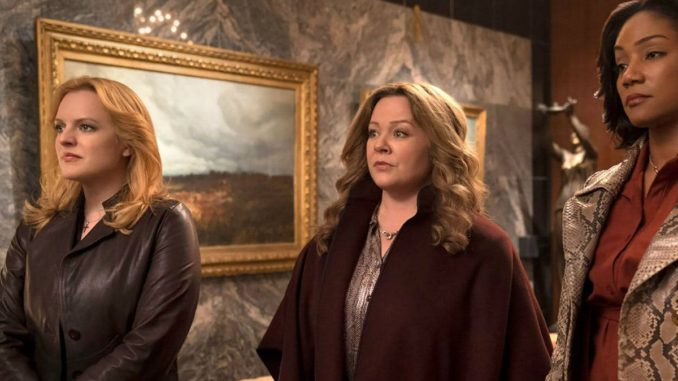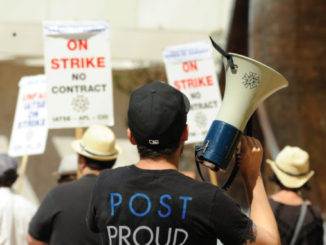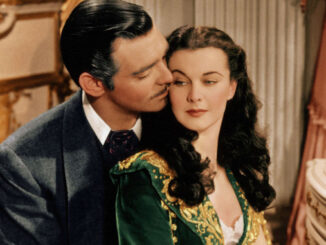
by Patrick Z. McGavin
Andrea Berloff’s period gangster thriller “The Kitchen” and Casey Affleck’s dystopian drama “Light of My Life” are very different movies, but they share two things in common.
Both feature actress Elisabeth Moss. And both were cut by editor Christopher Tellefsen, ACE, who was nominated for an Academy Award for his work on Bennett Miller’s “Moneyball” (2011) and whose long career included an early stint as Martin Scorsese’s archivist.
In Berloff’s debut feature, adapted from a DC Comic Book series and set in an evocative Hell’s Kitchen of the late Seventies, Melissa McCarthy, Tiffany Haddish and Moss play the wives of Irish gangsters who take over the local protection racket after their husbands are sent to prison following a botched robbery.
In an exclusive interview, Tellefsen talks about his art and craft and his adventures in the trade with masters such as Scorsese, Ralph Rosenblum, Thelma Schoonmaker and brash upstarts like David O. Russell and Harmony Korine.
CineMontage: You have two films that just opened with “The Kitchen” and “Light of My Life.” Did you work on them simultaneously, or back to back?
Christopher Tellefsen: “Light of My Life” was like two years ago. It was a very small film. I had time between some projects and they approached me to do the first go round. They were shooting in a very remote area way above Vancouver. I was in New York, and I did a first assembly and a first pass. Then it went away. [The editing was ultimately credited to Tellefsen and Dody Dorn, ACE. -ed.]
“The Kitchen” is the debut film as a director by Andrea Berloff, whose background is as a writer. Casey Affleck directed Light of My Life, and he comes from an acting background. What was the dynamic like, working with such young directors?
Tellefsen: I have worked with a lot of first-time directors, like “Metropolitan” (1990), which was Whit Stillman’s first film. Especially with writer-directors, it is a matter of them getting their feet wet and you are able to bring as much as you can to the table in terms of shaping the movie. Andrea was a dream to work with because she is number one, a lovely person, but also very much on top of her material. We just worked very closely and had a very interesting dynamic. I had a good time dealing with her.
Was she in the room with you during post?
Tellefsen: Quite a bit during post. Not smothering and constant, but very present.
The movie is adapted from a comic series. Did you and Andrea want to replicate the panels of graphic novel?
Tellefsen: There are a few images, like Ruby [Tiffany Haddish] in the back room with the high boots and she is looking down and she is holding the gun. That is a very graphic image. Some of the things Elisabeth [Moss] does, like going after the guy who was coming onto her. There is a certain amount. It was not a frame for frame
thing. It was not utilized as a storyboard or anything.
The comic is more of a graphic novel. It’s a very gritty, hard story of three women in this world that merges out of it and they become much harder than the men they meet. That is the real core of the story and where Andrea went with it. She also invented some characters, like Margo Martindale [as a mob matriarch].

It’s a very violent movie, and the fact that women are meting out that violence is unsettling for some people. I read a quotation from Andrea that she really wanted people to hear and feel the violence, like the sound of gunshots.
Tellefsen: Yes. We wanted the women to be them to be badass and hard. We very consciously wanted to create the late Seventies in Hell’s Kitchen, which was massively dirty. It was loud and it was nasty. It was real. We tried to bring that forward through the level of art direction. You couldn’t just go into Hell’s Kitchen now
and create that world. It has been completely gentrified. It is different now.
There were a few locations, like a butcher shop or the front of an apartment building in SoHo Kitchen, but I’d say 85 to 90 percent of the locations had to be looked for to be able to replicate the look of the past. There was a lot from Spanish Harlem and Brooklyn. The art department had literally trucks of garbage, labeled A, B and C, and they [had it] strewn it all over the place.
The film reconstructs a vanished past. We talk about recreating period detail as far as cinematography, production design, and costumes.
Tellefsen: And music.
As an editor, what is the greatest challenge in preserving that look and feel from the work you are doing?
Tellefsen: That is a good question. I’d say to give it a sharpness and edge as much as I could. You have all of these challenges you have editing any kind of piece. As far as a consciousness toward time period, I think a lot of the choices came from the strength of the performances and the dynamic between the characters. I was always drawn to three shots of the women because they were just great to see in that grouping. They twinned off each other very well. That was a conscious decision.
You also worked on Steve McQueen’s “Widows” (2018), which is very interesting given the overlap in storylines or parallel between the two films.
Tellefsen: That was very strange. I did some early work on “Widows.” Steve McQueen’s editor, Joe Walker, that he has worked with on all of his films, was not available. I worked for a while until he was available. There are similarities, but not exact. In “Widows,” there are four women, not three women. “Widows” is a heist movie. They don’t take over a way of life, they don’t take a business. They do a leftover heist of their husbands.
You are also connected with Thelma Schoonmaker and you served as a personal archivist for Martin Scorsese. In The Kitchen, the Seventies setting evokes Taxi Driver (1976) and the cutting style seems very indebted to Mean Streets (1973).
Tellefsen: I’d say that was more coincidental. I can’t say I approached the movie thinking I am going to make it feel like another movie. I feel like every film I have worked on is its own world, its own thing, and what I am trying to find is the absolute core and essence of itself. That is a process, getting the footage and getting
the performances and the dynamic between the characters and finding some rhythms that really make it right.
The process happens from the very first day you receive the footage until the very end of the mix and the end of the DI [digital intermediate]. You are constantly trying to create a world within itself. Music was huge. We had a wonderful music editor, Mitsuko Alexandra Yabe, who did some wonderful work. Throughout the mix,
we were always going to making it harsh, make it nasty. The sound crew was really great.
The movie has been attacked by critics.
Tellefsen: The [critical] response has been shocking.
The biggest confusion is about the tone. It’s a gangster movie with a feminist twist, but also there’s a lot of black humor in the movie, especially in the motif about dismemberment of corpses. It is as if people are not sure how to respond to the material.
Tellefsen: That’s a wonderful scene. Elisabeth is fantastic, and the dynamic between her and Domhnall [Gleason] is really strong. They are kind of wonderful. The shock of what happens of what happens to her and the timing of that is very interesting. What happens, happens. She is just a wonderful performer, and Tiffany is marvelous and Melissa [McCarthy] is a master. She is an amazing performer.
The formal patterns and connections in your work are very interesting. I look at Whit Stillman’s “Metropolitan,” a restoration comedy about the social manners of privileged Manhattan teenagers, and Larry Clark’s “Kids” (1995), which is obviously a wholly different class. You edited both films, and that makes for quite a fascinating double bill.
Tellefsen: When I read the script for “Metropolitan,” I thought it was so different, like Phillip Barry in the Thirties, like [George Cukor’s] “Holiday” (1938) or “The Philadelphia Story” (1940), that was the closest thing I could think of in terms of genre. It was so new and fresh in its own way and so odd. Whit is one of the most interesting and idiosyncratic people I have ever worked with.
I edited “Metropolitan” in ‘89-90, and “Kids” in ‘94. It was very interesting because the kids in both films are about the same age and from the same area. There were some overlaps; the first scene of “Kids” was on the Upper East Side, the girl that Leo Fitzpatrick was with in the first scene. It’s a nice apartment, he jumps down the stairs and spits on the table and he meets Casper [Justin Pierce] outside and they walk down York Avenue. That is just one example of the overlap. The films are very different in tone.
With “Metropolitan,” the thing I thought about when I first started to get the footage is this almost belongs in a Margaret Mead film festival next to a different tribe. It was very tribal, and really interesting culturally on that level. I joined the film about a week into production, and I saw the group of them in a scene, and I was thinking to myself, they look like a group of people that have known each other their whole life. They look like kids who are very tight. But they all came from different places.
When we were ready to expose that film to the world, I remember showing it on a flatbed. The first cut was way over two hours and it needed so much shaping and people were a little hesitant about it. The first person we screened it for when we were just about finished was a programmer for the Montreal Film Festival and
this woman absolutely hated it. We were devastated. We were so upset. We didn’t know what to do.
Then we screened it for the [Independent Film Project] people, and this was just as the Angelica Film Center started and there was a festival. We were nervous, and they loved it. Whit had another screening and Lindsay Law from American Playhouse saw it and picked it up. That covered all the costs. The film was made for
nothing, $235,000, with a 35mm blow up. It did great at Sundance and it did great at Cannes. Ira Deutchman was the producer’s rep and it was picked up by New Line Cinema and it did very well.
Getting back to Thelma Schoonmaker and Scorsese, your first credit was as an assistant on “The Color of Money.” What a way to start your career. How did that happen?
Tellefsen: I was an apprentice. It was 1986. I had managed to get a lowly gig on “The Color of Money.” Marty’s archive collection was just growing then. Prints would come in, and I was delegated to repair them and check them out. Marty liked what I was doing and he asked me to work on his archive, which I did for six months. But it was not what I wanted to do. I didn’t want to be an archivist. I had access to his collection, which was amazing. I had a VCR and I would take home the films every night and have something exciting to watch. I was heavily exposed to Italian neorealism and especially the Italian comedies of the late Fifties and Sixties.
At that time, Thelma Schoonmaker was married to Michael Powell. He was really lovely and a great presence. We’d have screenings of his films. Marty would have screenings all the time, and he would invite us. He had a screening of [Federico Fellini’s] “8½,” and he had just gotten a silver print. It was so stunning. It looked as though it was shot three minutes ago. It was so fresh and so gorgeous.
Marty was very generous with things like that. He was always excited about stuff. The first day, I walked in to bring in coffee, and there was a huge poster of the Mario Bava film “Blood and Black Lace” (1964). I said, “I love that film,” and Marty talked about it for half an hour.
Another legendary figure, Ralph Rosenblum — wasn’t he another early mentor?
Tellefsen: Ralph was like the crustiest of the crusty. He was amazing. That was how I ended getting connected to the apprenticeship on “The Color of Money.” I had actually been editing before I was an apprentice. Right out of college, a friend got me a gig on Italian television doing these documentaries that were about eccentric Americans. It was really fun, but it only lasted about six months.
I was not sure what I was going to do. Then I got onto this Jackie Mason film called, “A Stroke of Genius.” It was just terrible. It was shot in Florida. There was a big mess. It all fell apart. The producers and everybody left. A year later they resurfaced with another movie called “Stiffs.” Ralph Rosenblum had directed it, and it was being edited by Sonya Polonsky, who was a wonderful editor who did John Sayles’s early films, like “Baby It’s You” (1983).
I got to know Sonya, and someone came to help her for a week. It was a young man named Jimmy Kwei, who was going to be the first assistant on “The Color of Money.” I told him I’d do anything. I’d sweep the floor. He said, “Are you sure? You are already cutting.” I said, “I am cutting garbage.”
After working on that, doing the archive and one other assistant gig, I just decided it was too frustrating. I did not enjoy assisting. Assisting is a real profession, and it’s a real thing in itself. I have a great deal of respect for it, and I am very dependent upon my assistants. My passion is editing. I cut a short film at that point, and that short got me another little film. Then I got “Metropolitan,” and that kicked everything in.
How do think your own style and ideas about editing have evolved since your started?
Tellefsen: I think what I really try is face everything in the freshest way I can, so that every new film is a whole new thing, a whole new experience. Of course, there is specific grammar that I will always use, but I am always looking for something to turn a little bit on its head. I love crashing cuts. I love jump cuts when
they feel right. I don’t like them just to do it. I am always looking for these contractions that make sense, or you are surprised that they work kind of thing.
I try to challenge my work, and I don’t want things to feel too conventional. I also try to keep very much in the idea that each piece has its own internal rhythm and its own shape that will evolve with care.
You’ve worked with Scorsese, David O. Russell…
Tellefsen: David was just wonderful. “Flirting with Disaster” (1996) was such a treat. I had so much fun. There are so many interesting aspects about that film. The scene at the dinner table, there was a whole version of the shooting where the camera moved a lot. David said, “That’s not working,” and he then he actually did it much more straightforward. Then he found little pieces with the moving camera that worked within that, and it felt surprising and odd.
In my opinion, it is very seminal and I think a lot of comedies that wanted to be it but never were. After that, I kept getting a lot of comedy scripts, and so many of them were terrible. The only comedy after that I did after that was “Analyze This” (1999), which I loved, a straight-up, solid comedy that went for laughs all the time.
In addition to the other filmmakers we have talked about, you have also made films with Bennett Miller, Milos Forman, M. Night Shyamalan, Robert Benton and Harmony Korine.
Tellefsen: I went to art school, I did not go to film school. My last two years of art school, I had as my teacher the great experimental filmmaker, animator and painter Robert Breer [1926-2011]. In many ways, [Korine’s] “Gummo” (1997) is much closer to any kind of formative experiences of mine. It was interesting that the first film of mine that I edited that took off was “Metropolitan.” It was all talk. I had to figure out how to make that flow and feel. I wanted people to want to be in that world, and a lot of that had to do with the music and the charm of the characters.
That’s quite a range of directors as far as style and sensibility. What is the most important part of a director and editing collaboration?
Tellefsen: The first thing that comes to mind is respect and finding a way to be on the same page and be challenging at the same time. To be completely understanding of what the thing you are working on is, and also not pander or make easy choices.
Patrick Z. McGavin is a Chicago-based film critic and cultural journalist. His writing on film is frequently published at RogerEbert.com and the Chicago Reader.





